Soil pH is a scale used to measure the soil’s acidity or alkalinity. Alkaline soil is called “sweet” by gardeners and farmers; acidic soil is called “sour.” Soil pH is measured on a scale of 0 to 14, with 7 being neutral. Acidic soil measures below 7; alkaline soil measures greater than 7.
Soil pH is important because plants can’t absorb nutrients if the pH is too high or too low. A pH test will not tell you what nutrients are in the soil, but it will tell you whether the soil is too acidic or too alkaline for nutrients to be released.
Soil pH
Soil pH affects how vegetables and other plants grow.
Vegetable crops and other plants get most of the nutrients they need from the soil; the nutrients–mostly minerals–are dissolved in soil moisture and taken up by plant roots (other nutrients come from the air and are taken in by plant leaves). A plant root’s ability to absorb mineral nutrients is affected by the chemical balance of what is called the soil solution; soil solution is a mix of mineral nutrients and soil moisture. If a soil mineral can’t dissolve in soil moisture it will not be available as a nutrient for uptake into the plant.
Soil acidity and alkalinity
A mineral nutrient’s ability to dissolve in soil water is chemically affected by the soil’s acidity or alkalinity, essentially the amount of calcium—chalk, and lime—in the soil. If soil is too acidic or too alkaline many mineral nutrients will not dissolve in soil moisture.
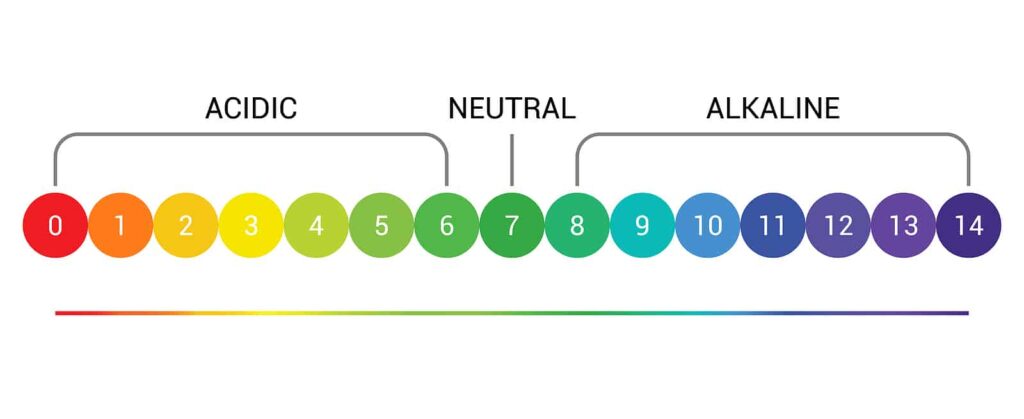
pH scale
pH is a measure of the soil’s acidity or alkalinity. The pH scale or measuring stick numbers from 1 to 14:
- 1 is the most acidic
- 14 the most alkaline
- 7 on the pH scale is neutral
(By way of reference, lemon juice has a pH of 2; orange juice has a pH of 4; baking soda has a pH of 8.5 and ammonia has a pH of 11.5.)
Most nutrients needed by vegetables become chemically available when the soil pH falls between 6.0 and 7.5.
Optimal pH range for vegetables
| Soil pH | Vegetable |
| 6-8 | Asparagus, beet, cabbage, muskmelons |
| 6-7.5 | Peas, spinach, summer squash |
| 6-7 | Cauliflower, celery, chives, endive, horseradish, lettuce, onions, radishes, rhubarb |
| 5.5-7.5 | Corn, pumpkin tomatoes |
| 5.5-6.8 | Beans, carrots, cucumbers, parsnips, peppers, rutabagas winter squash |
| 5.5-6.5 | Eggplant, watermelons |
| 4.8-6.3 | Potatoes |
Plant nutrients in the soil
The most important mineral nutrients essential for plant growth are nitrogen, phosphorus, and potassium. Nitrogen promotes leafy growth; phosphorus is important for root growth and the production of flowers, fruits, and seeds; potassium is necessary for the development of leaves and roots and all-around plant health. Other nutrients taken up through the soil solution are calcium, sulfur, and magnesium in moderate quantities and trace quantities of iron, manganese, zinc, boron, copper, and molybdenum.
How soil nutrients get “locked”
When the soil pH falls below 5.0 and becomes moderately acidic, nitrogen, phosphorus, and potassium cannot be dissolved in the soil solution and become chemically unavailable or “locked up.” Calcium and magnesium also become unavailable in moderately acidic soil. When the soil pH rises above 7.5 and becomes increasingly alkaline, iron, manganese, and phosphorus become unavailable or “locked up.”
Microorganisms and soil acidity and alkalinity
Soil acidity and alkalinity also affect soil-dwelling microorganisms and earthworms which are essential to the decay cycle and soil health. Many microorganisms become less active as the soil becomes more acidic, and they stop activity altogether when the pH falls below 4.5.
The importance of soil pH
Vegetables and other plants grow best when the soil pH is optimal for the plants being grown. It is important to match a plant to the soil pH or to adjust the soil pH to a plant’s needs.
Soil pH is important because a soil’s acidity or alkalinity determines what plant nutrients are available to plant roots. Nutrients in the soil—elements such as nitrogen, phosphorus, and potassium—become available to plants when they dissolve in water or soil moisture. Most plant nutrients will not dissolve when the soil is either too acidic or too alkaline.
Knowing the soil pH in the planting beds in your garden will allow you to group plants by their pH needs. Grow together plants with like pH needs, similar temperature tolerances, and nutritional needs.
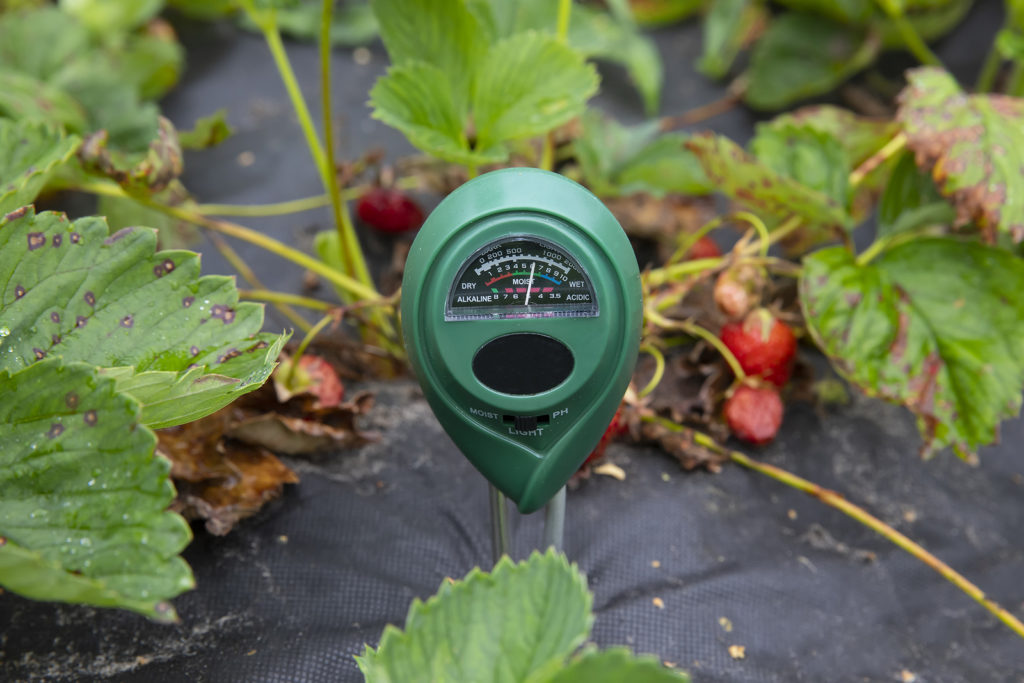
How to know soil pH
The results of a soil pH test will indicate how acidic or alkaline your soil is. Organic soil amendments are the best way to adjust soil pH. Adjusting soil pH is not an exact science and takes time.
A pH test number that is more than 0.5 on either side of the optimal pH number for the plants you want to grow will require a soil amendment or additive to adjust the pH. A pH test number that is within 0.5 of the optimal pH number for the plants you want to grow does not require soil amendments.
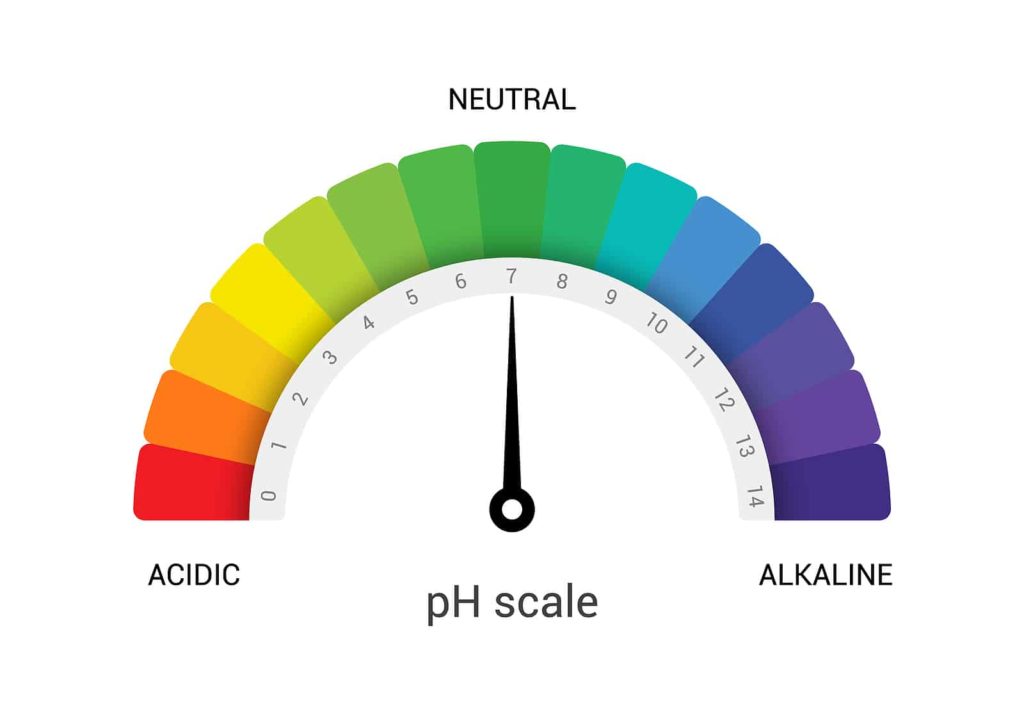
Testing the soil pH
You can test the soil in your garden yourself, or you can send it to a soil testing lab.
Home do-it-yourself soil-test kits test for soil pH (the relative acidity or alkalinity) and major soil nutrients–nitrogen, phosphorus, and potassium. DIY soil-testing kits do not test for micronutrients or organic matter content. The advantage of a DIY kit is that you can test individual beds and get immediate results.
Professional laboratory tests—from a commercial lab or from your state Extension Service–provide more information than home tests, usually pH, nitrogen, phosphorus, and potassium levels, values for secondary mineral elements and micronutrients, and also a report on organic matter in the soil. Professional lab tests cost more time and money than DIY tests.
How to take a soil sample
Take a soil sample on a dry day. Use a clean trowel or spade or a soil sampling probe—a length of pipe with a sharp to pierce the soil.
- Dig a hole six to eight inches deep.
- Take a thin slice of soil about an inch thick from the straight side of the hole. Trim the slice into thirds along its length—use the center or inner slice for the test.
- You can test each planting bed or take half-dozen samples from around the garden equally distant apart. Mix the samples in a plastic bucket; take your sample from this mix. (If you know your garden has very different types of soil in different areas of the garden, test each section separately.)
Home soil test kits
Home soil test kits commonly use pH-sensitive paper or film or water-soluble powder. Once you have a soil sample, add mineral-free distilled water to make a slurry then dip in the pH-sensitive paper or add a bit of your sample to the pH-sensitive powder (just follow the instructions that come with your soil test kit).
Compare the color of the paper or solution to those on the chart provided with the kit. Your soil will fall between a pH of 4.5 and 8.5. A chart with the kit will tell you if your soil requires amendments to change the pH or additional fertilizer for the plants you want to grow.
Digital pH meter
The availability of nutrients to your plants depends on how acidic or alkaline the soil is. A hand-held pH meter will give a reading of the soil’s pH after the prongs are inserted into the soil.
The greatest availability of nutrients–nitrogen, phosphorus, potassium, sulfur, calcium, magnesium, iron, manganese, boron, copper and zinc, and molybdenum—occurs when the soil pH is between 5.5 and 7.5.
When to test your soil
Test the soil periodically throughout the growing season. It is especially important to test before planting in Spring and when preparing your planting beds for the next season in Fall. If plants are not growing. A good time to begin adjusting the soil pH is in the fall; check the progress again in the sprig. Check the soil regularly–twice a year is ideal.
A soil sample from your garden can be tested by a soil lab. A lab test will make specific recommendations on how to correct soil that is too acidic or too alkaline. You can also test soil pH yourself with a home soil test kit or a portable pH meter.
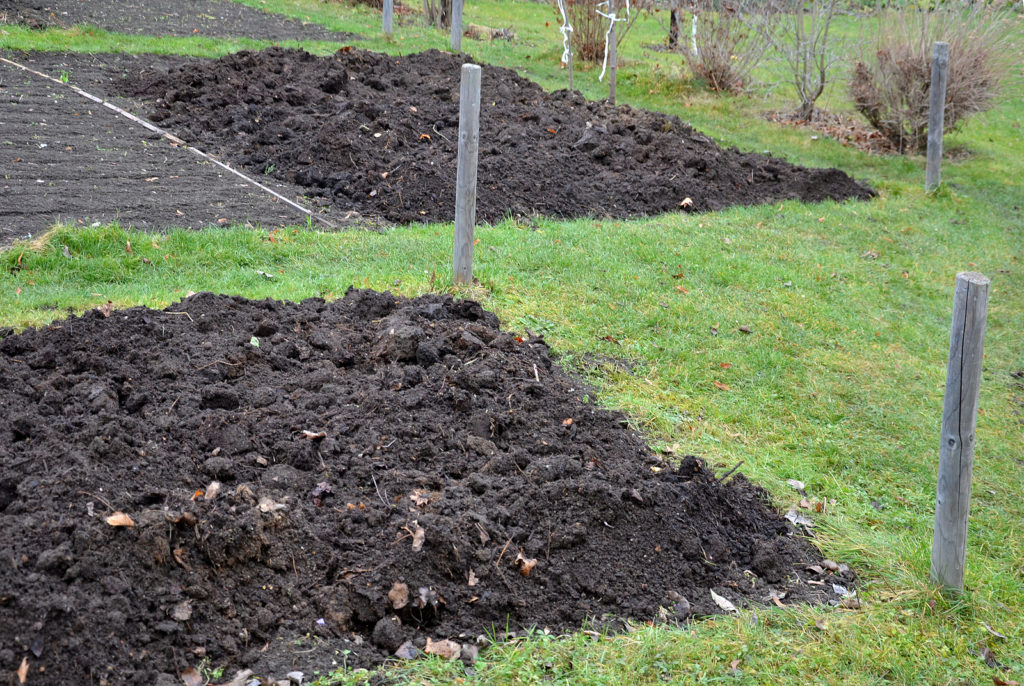
How soil pH is modified
The results of a soil pH test will indicate how acid or alkaline your soil is. Organic soil amendments are the best way to adjust soil pH. Adjusting soil pH is not an exact science and takes time.
A pH test number that is more than 0.5 on either side of the optimal pH number for the plants you want to grow will require a soil amendment or additive to adjust the pH. A pH test number that is within 0.5 of the optimal pH number for the plants you want to grow does not require soil amendments.
The quickest way to change soil pH is to add either agricultural sulfur (powdered sulfur, aluminum sulfate, or iron sulfate) to make alkaline soils more acidic or agricultural ground limestone to make acid soils more alkaline. The best long-term way to improve soil pH is to add other slower, but longer-acting organic materials (see the lists below).
The amount of additives or amendments necessary to correct soil pH varies according to soil texture. Sandy soil requires the least amount of additive, loamy soil a bit more, and clay soil the most. To determine the texture of your soil, wet a bit of garden soil and rub it between your fingers; if the soil feels gritty it is sandy; if it feels smooth like flour it is loamy or silty, if it feels sticky or slippery it has high clay content.
If you are adding agricultural sulfur or ground limestone to your garden, follow the recommended application rate listed on the package or bag. The amount will vary according to the type of soil in your garden and the number of square feet you are amending.
After adding sulfur or limestone or any soil additive to your garden re-test the soil in 40 to 60 days. Expect small changes to the pH—0.5 to 1 unit at most. Allow at least five or six weeks between the applications of soil amendments. Work steadily towards achieving the pH that will be ideal for plants you want to grow. Changing the soil pH by one unit each year is reasonable.
A good time to begin adjusting soil pH is in the Fall; check the progress again in the Spring. If you begin the process in Spring, start early–at least three weeks before planting. This will allow soil additives to begin to break down and start working. Check the soil pH regularly—twice a year is ideal.
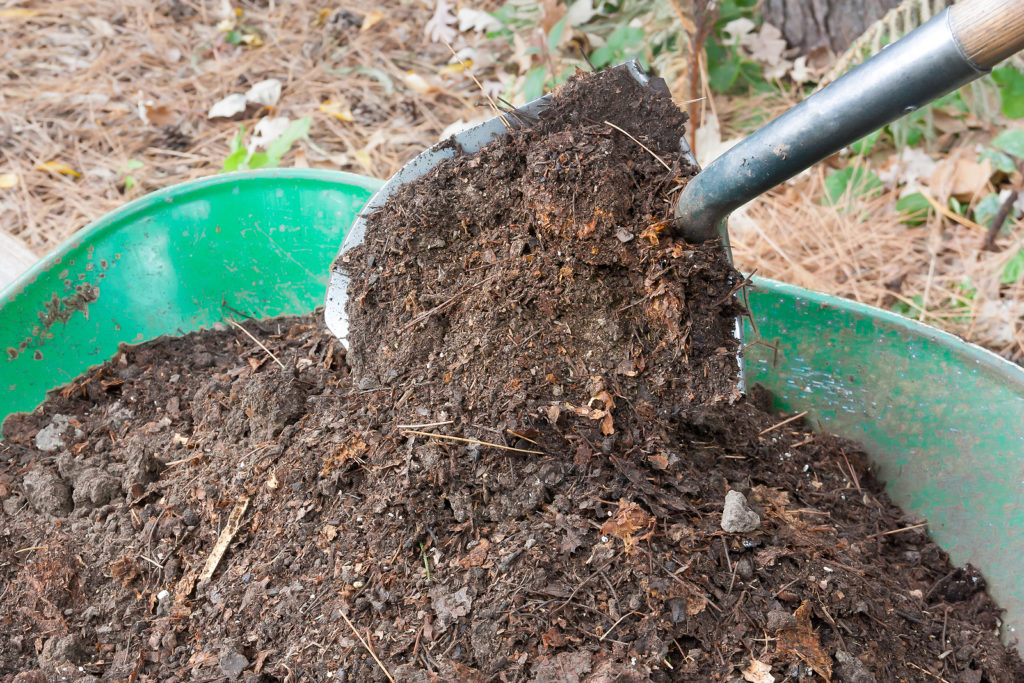
Organic materials to adjust soil pH
Adjusting alkaline soil
Regions that are very dry and droughty can have alkaline soil. It is rare that soils are too alkaline, but if that is the case in your garden add sulfur to the soil. Elemental sulfur, Epsom salts, gypsum, and fish emulsion are three sources of sulfur. To correct alkaline soil, add elemental sulfur at the rate of 4 pounds per 100 square feet for each unit of pH above 7. Again, follow soil lab recommendations when adjusting soil pH.
The best way to lower soil pH to neutral 6.0 to 7.0 is to add naturally acidic organic materials:
- Aged compost
- Aged sawdust
- Wood chips
- Leaf mold
- Cottonseed meal
- Pine needles
- Coffee grounds
- Fresh manure
- Oak leaves
- Ground-up oak bark
- Pine needles
If your garden is in a region of low rainfall, a high pH could be the result of accumulated salts. Flush salts below the root zone of sensitive plants such as beans, carrots, onions, and peppers by watering regular non-saline water. Also add compost, mulch, or leaf mold.
The best time to correct soil alkalinity is in the Fall; that will allow organic materials time to decompose (organic materials tie up nitrogen while decomposing).
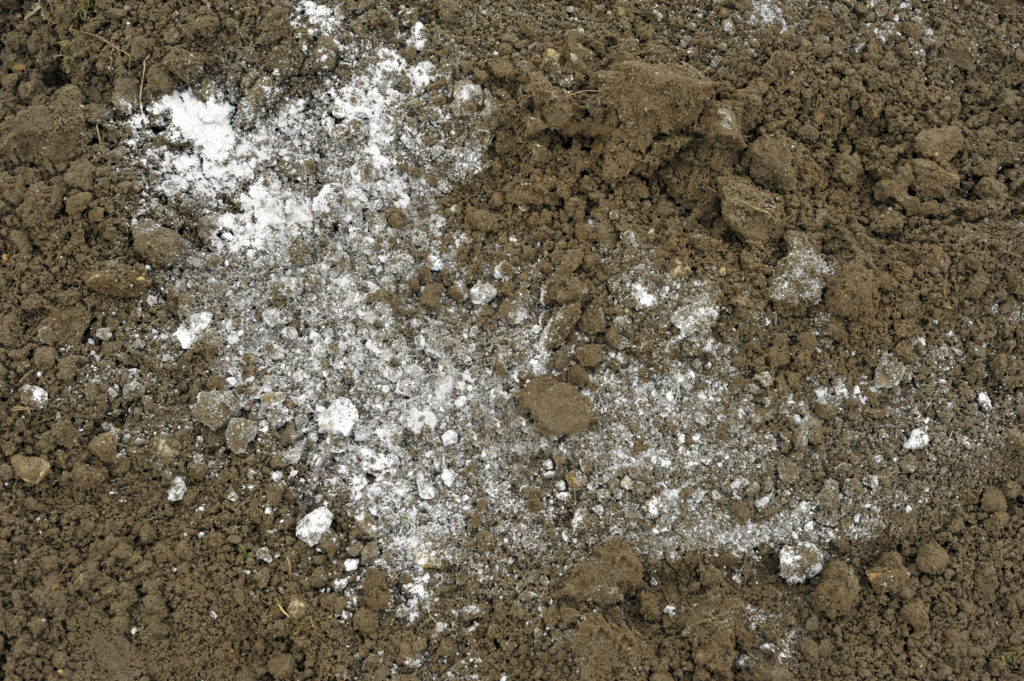
Adjusting acidic soil
To improve acidic soil, add alkaline material, a process commonly called liming. Ground limestone, specifically calcitic limestone, is the most common material used to raise the soil’s pH. Ground limestone is slow to break down in the soil and is best added in autumn to improve the soil in time for spring planting. As a general rule, add 4 to 5 pounds of ground limestone per 100 square feet for each unit of pH below 6.5.
Regions with heavy rainfall and forest cover tend to have acidic soil. A soil that tends toward acidic should be limed every third or fourth year in the autumn. Apply lime a month before adding manure or compost to avoid undesirable chemical reactions. It is important to note that soil texture also can affect how additives raise or lower soil pH so if your soil is problematic have it tested and follow the soil lab recommendations.
To raise soil pH of acid soil add any of these long-acting organic materials:
- Bonemeal
- Ground clamshells
- Ground eggshells
- Ground oyster shells
- Hardwood ashes
- Fine-ground agricultural lime: dolomitic lime (if the soil test reveals a magnesium deficiency) or calcitic lime (if the soil test reveals a calcium deficiency). The general guidelines for applying limestone to increase pH by one unit across 100 square feet are 3 pounds for sandy soil; 5 pounds for sandy-loam soil; 7 pounds for loam soil; and 8 pounds for clay soil.
The best time to correct soil acidity is in the Fall. If you want to correct soil acidity in the Spring do so at least three weeks before planting; that will allow time for soil additives to begin to work
Altering soil pH is not an exact science and takes time; you should not expect an immediate change. After adding lime or sulfur to your garden re-test the soil in 40 to 60 days. Expect small changes to the pH–0.5 to 1 unit at most. Work steadily towards achieving the pH that will be ideal for the plants you want to grow.
Soil pH requirements of crops
This list will allow you to group plants in your garden according to their soil pH tolerances. You will find that in the lists below, some plants may be repeated if they have a wide soil pH range tolerance; that is some plants will grow equally well in acid or alkaline soil.
Acidic soil crops
The following crops prefer a pH of 4 to 5.5:
- Blackberry (5.0-6.0)
- Blueberry (4.5-5.0)
- Cranberry (4.0-5.5)
- Parsley (5.0-7.0)
- Peanut (5.0-7.5)
- Potato (4.5-6.0)
- Raspberry (5.5-6.5)
- Sweet potato (5.5-6.0)
Somewhat acidic soil crops
The following crops can tolerate a pH of 5.5 to 6.5:
- Apple (5.0-6.5)
- Basil (5.5-6.5)
- Carrot (5.5-7.0)
- Cauliflower (5.5-7.5)
- Chervil (6.0-6.7)
- Corn (5.5-7.5.)
- Cucumber (5.5-7.0)
- Dill (5.5-6.5)
- Eggplant (5.5-6.5)
- Garlic (5.5-7.5)
- Melon (5.5-6.5)
- Parsley (5.0-7.0)
- Pepper (5.5-7.0)
- Pumpkin (6.0-6.5)
- Radicchio (6.0-6.7)
- Radish (6.0-7.0)
- Rhubarb (5.5-7.0)
- Sorrel (5.5-6.0)
- Squash, winter (5.5-7.0)
- Sweet potato (5.5-6.0)
- Tomato (5.5-7.5)
- Turnip (5.5-7.0)
Moderately alkaline soil crops
The following crops will tolerate a pH of 6.0 to 7.0 or greater:
- Artichoke (6.5-7.5)
- Arugula (6.5-7.5)
- Asparagus (6.0-8.0)
- Bean, pole (6.0-7.5)
- Bean, lima (6.0-7.0)
- Beet (6.0-7.5)
- Broccoli (6.0-7.0)
- Broccoli rabe (6.5-7.5)
- Brussels sprouts (6.0-7.5)
- Cabbage (6.0-7.5)
- Cantaloupe (6.0-7.5)
- Cauliflower (6.0-7.5)
- Celery (6.0-7.0)
- Chinese cabbage (6.0-7.5)
- Celeriac (6.0-7.0)
- Celery (6.0-7.0)
- Chinese cabbage (6.0-7.5)
- Chive (6.0-7.0)
- Cilantro (6.0-6.7)
- Claytonia (6.5-7.0)
- Collard (6.5-7.5)
- Cress (6.0-7.0)
- Endive/escarole (6.0-7.0)
- Fennel (6.0-6.7)
- Gourd (6.5-7.5)
- Horseradish (6.0-7.0)
- Jerusalem Artichoke/Sunchoke (6.7-7.0)
- Kale (6.0-7.5)
- Kohlrabi (6.0-7.5)
- Leek (6.0-8.0)
- Lettuce (6.0-7.0)
- Marjoram (6.0-8.0)
- Mizuna (6.5-7.0)
- Mustard (6.0-7.5)
- Okra (6.0-7.5)
- Onion (6.0-7.0)
- Oregano (6.0-7.0)
- Pak choi (6.5-7.0)
- Parsnip (5.5-7.5)
- Pea (6.0-7.5)
- Radicchio (6.0-6.7)
- Radish (6.0-7.0)
- Rhubarb (6.5-7.0)
- Sage (6.0-6.7)
- Salsify (6.0-7.5)
- Spinach (6.0-7.5)
- Squash, summer (6.0-7.0)
- Sunflower (6.0-7.5)
- Sunflower (6.0-7.5)
- Swiss chard (6.0-7.5)
- Tarragon (6.0-7.5)
- Tomatillo (6.7-7.3)
- Watermelon (6.0-7.0)
Crops with a wide tolerance to soil acidity or alkalinity
The following crops have the greatest tolerance for a wide range of soil acidity or alkalinity, from about 5.0 to 7.0:
- Alpine strawberry (5.0-7.5)
- Carrot (5.5-7.0)
- Cauliflower (5.5-7.5)
- Corn (5.5-7.5)
- Cucumber (5.5-7.0)
- Dill (5.5-6.7)
- Endive/Escarole (5.8-7.0)
- Garlic (5.5-7.5)
- Parsley (5.0-7.0)
- Parsnip (5.5-7.5)
- Peanut (5.0-6.5)
- Pepper (5.5-7.0)
- Rutabaga (5.5-7.0)
- Squash, winter (5.5-7.0)
- Tomato (5.5-7.5)
- Turnip (5.5-7.0)
Articles of interest:
Best Herbs for Container Growing
Garden Planning Books at Amazon:
- Vegetable Garden Almanac & Planner
- Kitchen Garden Grower’s Guide Vegetable Encyclopedia
- Vegetable Garden Grower’s Guide
- Tomato Grower’s Answer Book















